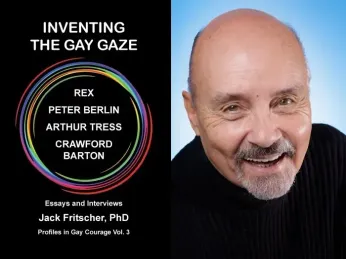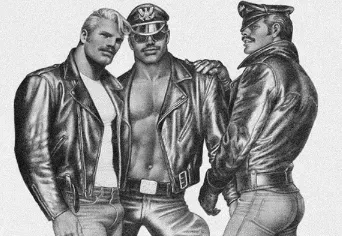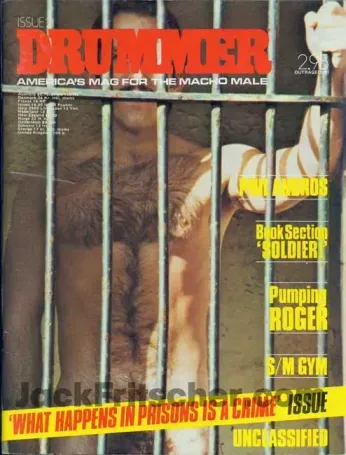
Sep 22
Jack Fritscher’s ‘Inventing the Gay Gaze’ – new essay collection focuses on four artists
Cornelius Washington READ TIME: 1 MIN.
All who are serious and passionate about the leather community know that it became manifest in San Francisco, and the publication that documented and formed the culture is Drummer Magazine. Bay Area author Jack Fritscher was the editor-in-chief at its most compelling and cutting edge, and he is the sage, scholar and historian enlightening the culture with his new book, “Inventing the Gay Gaze: Essays and Interviews, Profiles in Gay Courage, Volume 3.”

A touching exploration of four of the biggest San Francisco artists who were and are friends with Jack as they created their groundbreaking work, this award-winning series covers Rex, the snarky, obsessive, pointillist illustrator whose work was so intense and graphic that even rock icon Freddie Mercury wore one of his tees in a music video. His work still sells even after his passing last year.
Peter Berlin, the icy blonde porn fashionisto, whose videos and stills where he rocked leather and fetish gear brought him worldwide fame and adoration from pop artist Andy Warhol to haute couturiers Valentino (who cruised him from a limo and bowed to him in reverence before slow-dancing with him), and Jean Paul Gaultier (who he turned down a collaboration with). His observations about being self-created, his filmmaking skills and his comparison and love for the Black male body are compelling. He is also quite frank about aging, fame and business.
Arthur Tress truly covered the piers, waterfronts, abandoned buildings and parks and created dream-like aspirational images of homo-masculine sex for several other gay monthlies along with Drummer.
Crawford Barton documented the thriving, throbbing San Francisco scene from the hippies in the ’60s to the Sisters of Perpetual Indulgence, and the revered Castro Street clones in the late’70s (Crawford also did sterling work with the Bay Area Reporter). His work is the most loving and photojournalistic of the group and he is unfortunately the most underappreciated historically.
In appreciation of this must-have book for leather fetish buffs, the B.A.R. reached out to Jack for a brief and touching interview.

Cornelius Washington: When you finished the book, what moved you most about these four brilliant men?
Jack Fritscher: I wrote this book out of nostalgia for my four San Francisco friends and I finished with admiration for their humanity and how they suffered for their art and kept going despite insult and injury from straight and gay censorship, politically-correct critics, snotty galleries and disasters like the SF Folsom Street Barracks fire that destroyed a lifetime of art in Rex’s studio.
Tom of Finland is a great undercurrent in your book. Why is he so enduring and important for most creatives in leather fetish culture?
In the 1950s, the homomasculine Tom of Finland was the first influencer to promote homomasculinity as an emerging identity ideal. His joyous gravity helped change the gay gaze in queer media from twinkie chicken to masculine identified beef and bears. Without Tom, there would be no Drummer magazine or Mr. S leather fetish wear. He was born in 1920 and was already mature when his signature work debuted in Physique Pictorial magazine where 1960s artists like Rex, Peter Berlin and legions of other leathermen soaked up his liberating archetypes that shaped how we live today. Since 1979, the runway of the International Mr. Leather Contest has been a seasonal Tom of Finland leather fetish fashion show.
What constitutes a great work of leather fetish art other than just turning the viewer on?
In the psychology of art, entertainment turns you on and leaves you where you are, but art turns you on and changes you. My artists may present as erotic entertainers but their art is seductive. They use eros to seduce you and make you think. Masturbation is magical thinking. Many people fear change That is why the church and state are the main censors of art.
What was the first piece of leather fetish art that you paid for?
My first piece of leather fetish art was my Taurus tattoo inked by Cliff Raven.

Joseph Valliere, owner/operator of Underground Armour latex fetish clothing here in SF, wanted to know when you knew that Drummer was going to be a success?
When Drummer #21 (March 1979) hit the newsstands, we knew we had a hit on our hands. Reader response, subscriptions, and business ads poured in and tripled. Our press run up to 42,000 copies monthly because that perfect issues’ authenticity revealed to leathermen that Drummer was helping them create the very leather culture we reported on.
If you were to guest edit a new edition of Drummer, what would you be looking for in an artist to put in the magazine?
I love the talented guys at Jack McCullums’ revived Drummer. If asked, I’d look for graphic and verbal artists with a passion to fill their art with sex, a brain to fill it with ideas, and technical skills to make it pop.
How does it feel to be a cultural icon, to know that you’ve had such an effect and influence on leather fetish culture and sexuality in the LGBTQ community?
Is there a sash for that? I appreciate the compliment, but I am more iconoclast than icon. I’m just a leatherman who lives it up to write it down to entertain, document and change shit. That’s why my work on page and screen suggests how to dial up your identity and find your fetish, I post my books free to all at my fetish history website. I confess it warms my heart when men write emails saying that as lonely teens trying to find themselves in small towns, my work guided them when they needed help. As if I were a veteran of the mid-century sex wars, one sweet man wrote, “Thank you for your service.”
You wrote this wonderful book so these pioneers are remembered. How do you want future generations to remember you?
As a pioneer writer and photographer among the pioneer friends I’ve worked with and wrote about. I’d like the unborn future to find critical thinking and a useful narrative in my 70-year career as an eyewitness participant documenting the way we were before Stonewall, during the Titanic ’70s and after the iceberg of AIDS, it’s wonderful when gay men spill a drop for lost brothers.
‘Inventing the Gay Gaze: Essays and Interviews, Profiles in Gay Courage, Volume 3’ by Jack Fritscher, $24.95 paperback, $9.99 ebook, for sale at most outlets, and free online at
https://jackfritscher.com







